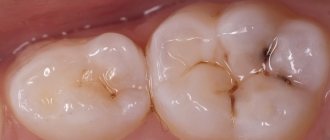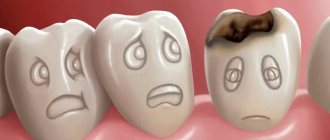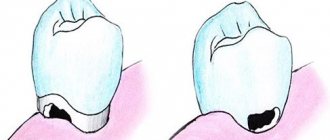Dental caries is a complex, slowly developing pathology that primarily affects dentin (hard dental tissue). We will explain in detail how caries begins and what types it is divided into in this article.
In this article
- Classification of dental caries
- What is the depth of development of caries?
- How to understand that it is caries?
- Types of caries by location
- Types of caries according to the severity of the process
- Types of caries according to its location
- Types of carious development according to the appearance of the process
- Types of caries according to the duration of the disease
Caries begins as a result of the adverse effects of external and internal factors. The most common cause is acid formed from the interaction of microorganisms with the carbohydrates that we eat. It destroys the enamel, gradually moving to its organic part. As a result of the destruction of dentin, a cavity is formed. If you do not consult a dentist and do not start treatment in a timely manner, an inflammatory process will develop in the core of the tooth (pulp), which then spreads deeper into the periodontium - connective tissue.
Classification of dental caries
This dental disease can be classified in different ways. The World Health Organization has identified the following types of caries:
- Enamel caries - characterized by softening of tooth enamel. Such caries begins after teething;
- Dentin caries - damage occurs to both enamel and dentin;
- cement caries - the tooth root is exposed, the cement is damaged;
- caries that has stopped - a dense dark spot appears, the process itself is stabilized;
- odontoclasia - occurs when the roots of baby teeth are reabsorbed;
- other and unspecified caries.
Clinical researches
Asept toothpastes are distinguished by their clinically proven effectiveness - the products have been repeatedly tested. As part of the tests, it was found that:
- regular use of preventive toothpaste ASEPTA ACTIVE for a month can reduce bleeding gums by 60%, improve the overall condition of the oral cavity by 44% and reduce inflammation by 33% (research);
- Regular use of preventive toothpaste ASEPTA SENSITIVE for a month can reduce bleeding gums by 62%, reduce sensitivity of teeth and gums by 48% and reduce inflammation by 66%. (study);
- regular use of professional toothpaste ASEPTA REMINERALIZATION after 4 weeks improved the condition of the enamel by 64% and reduced tooth sensitivity by 66% (study);
- Regular use of professional toothpaste ASEPTA GENTLE WHITENING for a month allows you to lighten tooth enamel by 1.5 tones, increases anti-caries effectiveness by 3.4 times and increases enamel remineralization by 2.6 times (research).
Sources:
- Report on determining/confirming the preventive properties of toothpaste “ASEPTA PLUS” GENTLE WHITENING” Author: doctor-researcher A.A. Leontyev, head Department of Preventive Dentistry, Doctor of Medical Sciences, Professor S.B. Ulitovsky First St. Petersburg State Medical University named after. acad. I.P. Pavlova, Department of Preventive Dentistry
- Clinical and laboratory assessment of the influence of domestic therapeutic and prophylactic toothpaste based on plant extracts on the condition of the oral cavity in patients with simple marginal gingivitis. Doctor of Medical Sciences, Professor Elovikova T.M.1, Candidate of Chemical Sciences, Associate Professor Ermishina E.Yu. 2, Doctor of Technical Sciences Associate Professor Belokonova N.A. 2 Department of Therapeutic Dentistry USMU1, Department of General Chemistry USMU2
- Report on the determination/confirmation of the preventive properties of personal oral hygiene products “ASEPTA PLUS” Remineralization doctor-researcher A.A. Leontyev, head Department of Preventive Dentistry, Doctor of Medical Sciences, Professor S.B. Ulitovsky First St. Petersburg State Medical University named after. acad. I.P. Pavlova, Department of Preventive Dentistry
- Clinical studies of antisensitive toothpaste “Asepta Sensitive” (A.A. Leontyev, O.V. Kalinina, S.B. Ulitovsky) A.A. LEONTIEV, dentist O.V. KALININA, dentist S.B. ULITOVSKY, Doctor of Medical Sciences, Prof. Department of Therapeutic Dentistry, St. Petersburg State Medical University named after. acad. I.P. Pavlova
- The role of anti-inflammatory rinse in the treatment of periodontal diseases (L.Yu. Orekhova, A.A. Leontyev, S.B. Ulitovsky) L.Yu. OREKHOVA, Doctor of Medical Sciences, Prof., Head of Department; A.A. LEONTIEV, dentist; S.B. ULITOVSKY, Doctor of Medical Sciences, Prof. Department of Therapeutic Dentistry of St. Petersburg State Medical University named after. acad. I. P. Pavlova
- Report on determining/confirming the preventive properties of toothpaste “ASEPTA PLUS” COFFEE and TOBACCO Author: doctor-researcher A.A. Leontyev, head Department of Preventive Dentistry, Doctor of Medical Sciences, Professor S.B. Ulitovsky. First St. Petersburg State Medical University named after. acad. I.P. Pavlova, Department of Preventive Dentistry
- Report on determining/confirming the preventive properties of commercially produced personal oral hygiene products: Asepta toothpaste used in combination with Asepta mouthwash and Asepta gum balm Head. Department of PFS Doctor of Medical Sciences Professor S.B. Ulitovsky St. Petersburg State Medical University named after Academician I.P. Pavlova. Faculty of Dentistry. Department of Preventive Dentistry.
What is the depth of development of caries?
A disease such as caries is best viewed from a developmental perspective. A similar classification is used by dentists around the world. Specialists develop a treatment program specifically for the patient, focusing on how the disease progresses.
Uncomplicated caries (simple)
- “White spot” stage, initial. A white or light brown speck appears on the tooth area; as a rule, it is matte and smooth to the touch. It is also called chalky. During this period, the patient does not experience any discomfort or strange sensations, but stains on the teeth are an alarm bell, and special attention should be paid to them. It is difficult to see them yourself; more likely, only a professional can detect the stains during an examination.
- Surface. The stain is no longer smooth to the touch, but rough. The patient experiences unpleasant sensations from sweet, sour and salty foods.
- Average. When average caries begins, the carious cavity reaches the dentin, but a thick layer prevents the pathological process from spreading further and covers the pulp. Pain appears from temperature changes, chemical and mechanical irritants, which disappears after 10-15 minutes. At this stage of the disease, the appearance of the tooth may remain almost unchanged, but small carious cavities and dark spots appear.
- Deep. A destructive stage at which the disease has practically reached the pulp, or rather the pulp chamber. When the specialist touches the damaged part with a probe, the patient experiences acute pain. In the picture you can see an impressive size cavity. With deep caries, pain occurs from almost everything: cold, hot, sweet, sour. Provided that the pain goes away within a few minutes, caries has not yet become pulpitis, which means that the affected tooth can be saved. It happens that even with deep caries, only minor damage is observed on the surface of the tooth, while nothing alive remains inside the tooth. Also, the last stage of carious disease is indicated by a strong smell from the mouth.
All of these varieties are simple, while the soft tissue remains healthy.
Complicated caries
Complex types of caries include:
- pulpitis, in which the soft tissue becomes inflamed - the pulp;
- periodontitis - inflammation of the tissues that surround the root of the tooth;
- granuloma formation - local inflammation with the formation of nodules.
To choose the type of treatment for a complicated type of caries, the depth of the process is taken into account.
Modern dentistry – does it hurt?
Today it is logical to position the patient’s comfort on the same level as the results of therapy. Proper use of anesthesia in a dental clinic allows you to achieve the best results even in the most difficult cases.
Today's best method of pain relief in dentistry is the introduction of formulations based on articaine, a component that has minimal effects on the human vascular system and has a long-lasting effect.
In practice, there are several techniques for pain relief:
- applique. The doctor does not use a syringe or needle; the drug is applied to the mucous membrane in the form of a spray or using a gel-soaked tampon. This method of pain relief is used for relatively painless manipulations, for example, when giving injections to children;
- infiltration The doctor injects an anesthetic into the upper part of the tooth root. This anesthesia allows a person to be relieved of pain when treating deep caries of one tooth. The only condition for ensuring maximum effectiveness of the procedure is the introduction of the drug into the root of the upper tooth (due to the anatomical features of the jaw structure);
- conductor. The doctor injects the drug into the nerve or near the nerve trunk. The patient loses sensitivity in the local area for 2-3 hours;
- intraligamentary. Otherwise, the technique is called intraligamentous. The dentist injects an anesthetic with a special thin needle into the periodontium itself. This anesthesia allows you to “freeze” half of the jaw and lasts about 40 minutes. The method is most common in pediatric dentistry.
How to understand that it is caries?
Caries in the spot stage can be mistaken for hypoplasia or fluorosis; superficial caries has similar features to wedge-shaped defects and dentin erosion. It is important not to confuse caries with other diseases. To distinguish caries from fluorosis and hypoplasia, the affected area is stained with a special dye. Dyes are activated only during caries. The period of development of the pathology is also taken into account: hypoplasia and fluorosis develop in infancy - before teething, and caries - after eruption on the “weak” areas of the tooth from negative external influences.
Types of caries by location
It is mainly the location that indicates the cause of the pathological process. Depending on the location, there are the following types of caries:
- Fissure. It begins in the grooves and pits of the chewing surfaces of the teeth (fissures), where microorganisms from food particles remain. Carious destruction occurs quickly, since the enamel layer here is much smaller;
- Contact. The most poorly diagnosed type of caries. Occurs on the distal surface, i.e. located on the edge of the tooth, which faces the adjacent one. Develops when food debris and plaque accumulate. A person turns to a dentist in advanced cases due to the fact that pain appears at a late stage of the disease;
- Cervical. The most common variety. It appears at the point of contact between the tooth and gum from the accumulation of food particles that form plaque, where microorganisms multiply. Erosion destroys the cementum of the tooth root. The disease is quite dangerous and requires mandatory treatment;
- Circular. A complex type of cervical caries, it seems to form a circle at the junction between the gum and the tooth itself. If the disease is not treated in time, crown destruction may occur. This is a common type of caries in primary teeth. It affects the front teeth and labial surface in children under 3 years of age with reduced immunity. Gradually spreads and covers the palatal surface and is localized around the entire crown of the tooth.
Choosing a filling
Previously, mainly mineral cements, acrylic and epoxy, and amalgams were used to make fillings. Today, outdated fillings, which were imperfect in terms of fixation and aesthetics, have been replaced by modern inlays. They improve the adhesion strength to the tooth surface, do not require labor-intensive installation, and are biocompatible with the human body. Among them, the most used are: composites, glass ionomer cements, ormocers, compomers. Materials can be combined to achieve the desired effect.
Types of caries according to the severity of the process
There are the following types of caries process according to the speed and form of the disease:
- The compensated form is due to the slow development of the disease. Thus, the process usually develops with chronic caries;
- Subcompensated form - develops with average intensity, which is typical for a specific age group;
- Decompensated form (“acute caries”) - when compared with the average indicators of the age group taken, the symptoms of caries in this form are more pronounced, the disease develops quickly. When almost all the teeth in the area between the crown and roots are affected, this is the last form of acute carious process.
How caries progresses depends on individual characteristics. If the patient has a history of a serious illness associated with the immune system or the endocrine system, then from 5 to 20 teeth can be simultaneously affected in a short time. This form is called acute or decompensated. But the course of the disease may not be progressive. This type of caries will be a chronic or compensated form. But most often there are patients who develop a subcompensated form.
Treatment
The stages of treatment of dental caries are generally similar to the stages of treatment of ordinary caries:
- excision of affected tissue;
- treatment with medicinal and antiseptic drugs;
- the root is filled to recreate the shape.
The difference arises in the difficulty of accessing the site of the disease. First you need to clean the pocket and expose the root. As a rule, treatment takes place in two steps - on the first day, carious tissue is removed and the cavity is filled with a temporary glass ionomer filling. At the second appointment, the doctor examines the gums for healing and installs a permanent filling. To treat cement caries, Family Dentistry uses materials that are not affected by saliva, blood and gingival fluid - composites and glass ionomers.
If cement caries is not treated, pulpitis and periodontitis may develop, which will lead to tooth loss. To avoid such consequences, you should visit the dentist once every six months. During the consultation, the doctor will be able to detect signs of caries and, with little effort, get rid of this problem.
Types of caries according to its location
This classification was highlighted by researcher Black from America:
- Class I: cavities in the area of fissures and cavities on the teeth are affected;
- Class II: cavities on the contact surfaces of molars are affected;
- Class III: cavities on the surface of the canines and incisors are affected, the corners and cutting edges are not involved in the process;
- Class IV: cavities on the surface of the canines and incisors are affected, the corners and cutting edges are involved in the process;
- Class V: cavities in the area of the tooth necks are affected;
- Class VI: cavities with atypical locations are affected.











